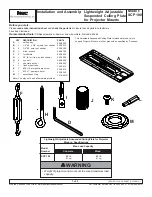
MXCB
5-2-55, Minamitsumori, Nishinari-ku, Osaka 557-0063 JAPAN
Phone: +81(6)6659-8201 Fax: +81(6)6659-8510 E-mail: [email protected]
EM-1745 Rev.5 P. 6 / 6
FUNCTIONS
■
DEFAULT SETTING
• MXCB Used Independently
In normal operating mode, the MXCB responds to UP/
DOWN signals from the computer in the preset ramp rate.
If the computer fails, this will be detected as a “STOP”
command and output will be held at the value prior to the
breakdown. You can increase the output signal by closing
across the terminals 9 – 11, and decrease it by closing 10 –
11. The output responds in the preset ramp rate.
COMMAND
TERM
SIGNAL STATUS
UP
3 – 6
1 0 0 1 – – – –
Computer
DOWN
4 – 6
0 1 0 1 – – – –
STOP
5 – 6
1 1 1 1 0 0 0 0
ST/STL
UP
9 – 11
– – – – 1 0 0 1
DOWN
10 – 11 – – – – 0 1 0 1
Output of the MXCB
1 – 2
↑ ↓
H H
↑
↓
H H
[Keys] 1 : ON
0 : OFF
–
: ON or OFF
H : Hold
↑
: Increase
↓
: Decrease
• MXCB Used in Combination with ST/STL
In normal operating mode, the MXCB responds to UP/DOWN signals from the computer in the preset ramp rate. If the com-
puter fails, the “STOP” command will override computer output and put the unit in the manual operation mode by the ST/
STL. Using the top-mounted UP or DOWN key, output can be increased or decreased in the preset ramp rate.
Output signal value can be read on the top-mounted indicator.
For more precise control, use the monitor terminals. Also the computer input can be overridden with the AUTO/MANUAL
selector on the Soft-Terminal. This is useful when you need to change the output quickly during automatic operation by the
computer control.
CHECKING
1) Terminal wiring: Check that all cables are correctly con-
nected according to the connection diagram.
2) Power input voltage: Check voltage across the terminal
7 – 8 with a multimeter.
3) Output at STOP signal OFF: The output does not re-
spond to UP (3 – 6) or DOWN (4 – 6) signals.
4) Output: Check that the load resistance meets the de-
scribed specifications.
ADJUSTMENT PROCEDURE
This unit is calibrated at the factory to meet the ordered
specifications, therefore you usually do not need any cali-
bration.
For matching the signal to a receiving instrument or in case
of regular calibration, adjust the output as explained in the
following.
■
HOW TO CALIBRATE THE OUTPUT SIGNAL
Use a signal source and measuring instruments of sufficient
accuracy level. Turn the power supply on and warm up for
more than 10 minutes.
1) Reset all setting.
2) Turn the unit into Program mode.
3) Set the PV display to show 0.0 and adjust the output to
0% (ITEM 06).
4) Set the PV display to show 100.0 and adjust the output to
100% (ITEM 07).
5) Set the PV display to show 0.0 again and check the out-
put.
6) When the output value is changed, repeat the above pro-
cedure 3) – 5).
7) Return the unit into Monitor mode.
MAINTENANCE
Regular calibration procedure is explained below:
■
CALIBRATION
Warm up the unit for at least 10 minutes. Apply 0% and
100% input signal. Check that the output signal for the
respective input signal remains within accuracy described
in the data sheet. When the output is out of tolerance, re-
calibrate the unit according to the “ADJUSTMENT PRO-
CEDURE” explained earlier.
LIGHTNING SURGE PROTECTION
M-System offers a series of lightning surge protector for
protection against induced lightning surges. Please contact
M-System to choose appropriate models.
























